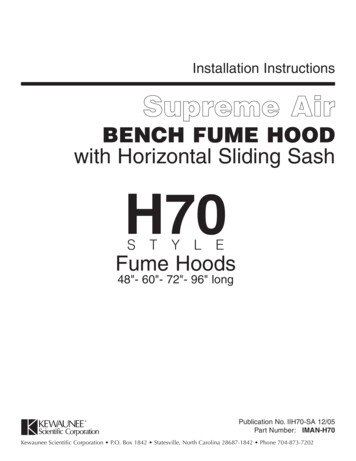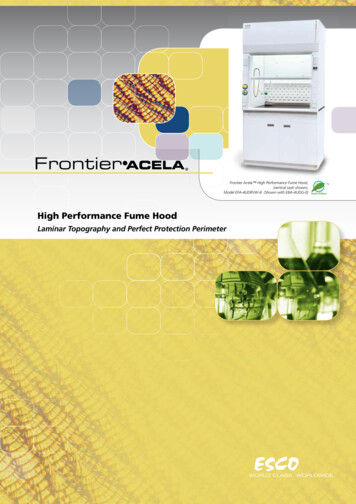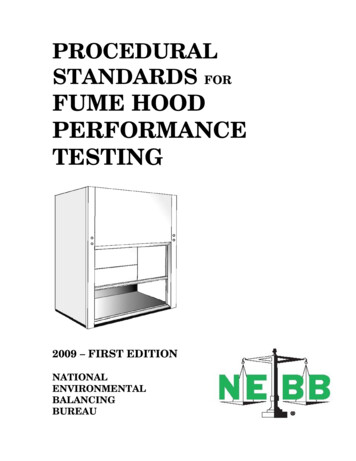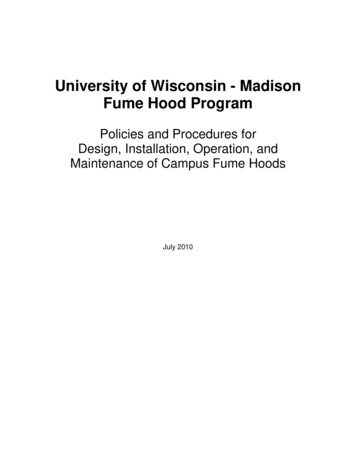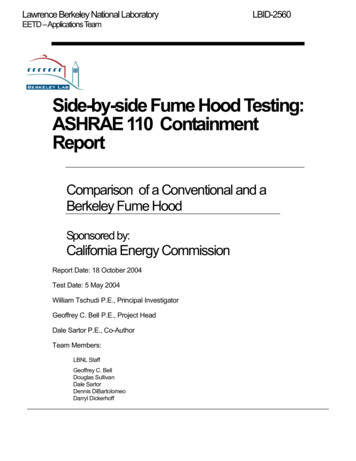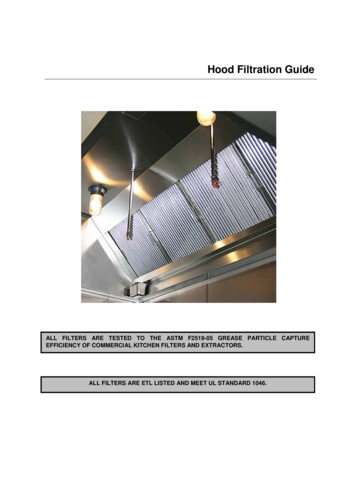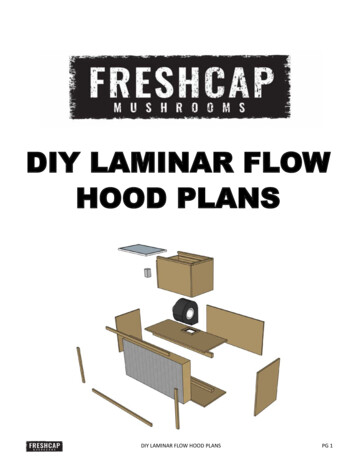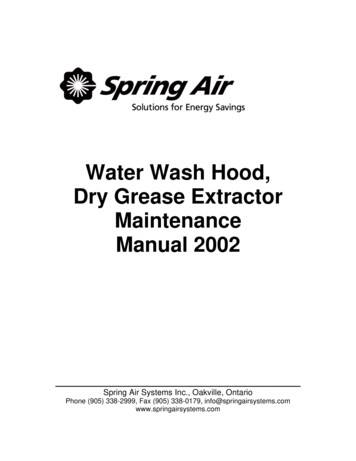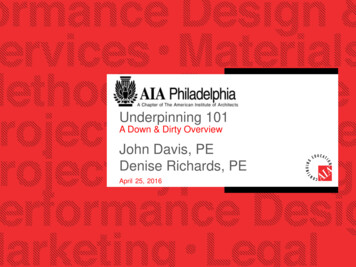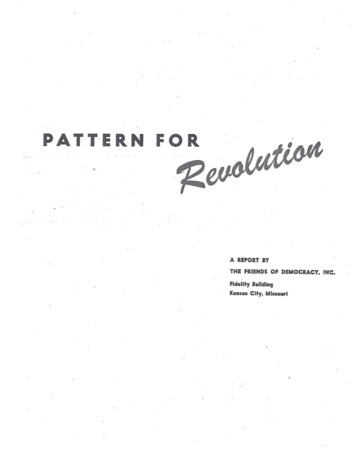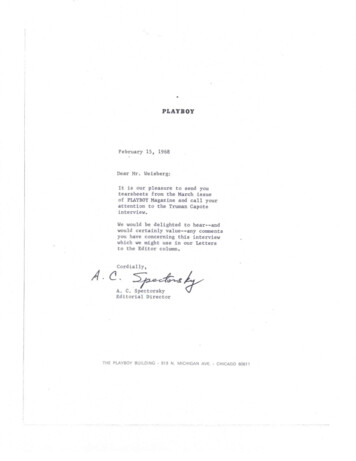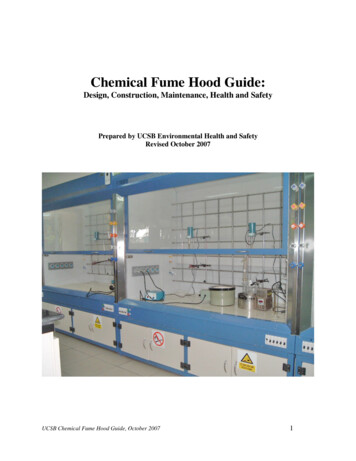
Transcription
Chemical Fume Hood Guide:Design, Construction, Maintenance, Health and SafetyPrepared by UCSB Environmental Health and SafetyRevised October 2007UCSB Chemical Fume Hood Guide, October 20071
ContentsIntroduction and References.3Construction, Installation and Renovation .4Laboratory Design .Supply Air .Variable Air Volume Systems .Fume Hood Construction and Installation .Ductwork . 9Exhaust Fan .Exhaust Stack .Plumbing .Electrical .Sashes .Special Use Hoods .Perchloric Acid Hoods.Iodination Mini Hoods .45671011111112131313Servicing and Dismantling .13Before a fume hood is serviced or dismantled . 13Fume hood Service Procedure .13Testing and Certification .14Out of Order Sign .15UCSB Chemical Fume Hood Guide, October 20072
IntroductionUCSB has adopted the following policies and procedures for the design, installation, renovation,maintenance, and dismantling of chemical fume hoods on the UCSB campus and affiliatedfacilities. This document was prepared by Environmental Health & Safety and reviewed byrepresentatives from Design and Construction, Physical Facilities and Budget and Planning.These guidelines reflect federal, state, local, and University health and safety regulations andpolicies. The guidelines do not stand alone, but must be incorporated with other applicablestandards into the design and construction of a fume hood. Any questions not addressed hereshould be addressed by consulting the references cited below; particularly the OSHArequirements cited in the California Code of Regulations and the ANSI / AIHA National Standardfor Laboratory Ventilation. In this way, those who use and maintain chemical fume hoods willbe ensured of an adequate level of protection from the possible harmful effects of laboratorychemicals.ReferencesAir Movement and Control Association, Inc. (AMCA)American Industrial Hygiene Association, American National Standard for Laboratory Ventilation, Z9.52003American Conference of Governmental Industrial Hygienists (ACGIH), Industrial Ventilation Manual,2001 edition.American National Standard Institute, Fundamental Governing the Design and Operation of Local ExhaustSystems, ANSI Z9.2, 2006American Society of Heating, Refrigerating, and Air Conditioning Engineers (ASHRAE), FundamentalHandbook, 2005 ed.California Code of Regulations, Title 8, Section 5154.1., Section 5209, 5143.California Code of Regulations, Title 24.National Fire Protection Association (NFPA), Standard for the Installation of Blower and Exhaust Systems,NFPA No. 91-2004.Sheet Metal and Air Conditioning Contractors National Association, Inc. (SMACNA)Uniform Building Code as modified by Title 19, California Code of Regulations.UCSB Chemical Fume Hood Guide, October 20073
Construction, Installation, and RenovationListed below are policies and procedures to be followed as part of the fume hood construction,installation, or renovation process. These guidelines are divided into nine categories: LaboratoryDesign, Supply Air, Variable Air Volume Systems, Fume Hood Construction and Installation,Ductwork, Exhaust Fan, Exhaust Stack, Plumbing, Electrical and Sashes. A justification for eachrequirement is provided as appropriate.I.Laboratory DesignA. Laboratories with fume hoods must be designed to have no recirculation of airto that lab or any other spaces.Recirculation of lab air will result in indoor air quality problems.B. Fume hoods must be located so that persons exiting the lab do not have to pass infront of the hood.Potentially dangerous portions of experiments are usually conducted in a fume hood.Many lab fires and explosions originate in fume hoods. A fire or explosion in a fumehood located adjacent to a path of egress could trap someone in a lab. Also,turbulence from passing traffic can adversely affect hood performance.C. There must be two exits from rooms where new fume hoods are to be installed. If thisis not feasible, the fume hood must be situated on the side of the room furthest fromthe door. Note that per Fire Code, labs greater than 200 ft2 in area are required tohave a second fire exit. In many cases the exit can be into an adjacent room whichthen exits to outside or an exit corridor.A fire or chemical hazard, both of which often start in a fume hood, can render an exitimpassable. For this reason, all labs with fume hoods are required to maintain twounblocked routes of egress.D. Fume hoods must not be situated directly opposite occupied work stations.Materials splattered or forced out of a hood could seriously injure anyone seatedacross from it.E. Windows in labs containing fume hoods must be fixed closed.Breezes coming in through open lab windows can adversely affect the properfunctioning of a hood. Turbulence caused by these wind currents can easily bring thecontaminated air inside the hood out into the lab. Note that hood face velocities areonly about 1 mile/hr.UCSB Chemical Fume Hood Guide, October 20074
F. The use of magnetic hold-opens on fire-rated lab exit doors is allowed andencouraged. These must be connected to the building fire alarm system, such that thedoor closes automatically when a building fire pull station is activated.Without these hold-opens lab users tend to illegally wedge their fire doors open. Ifthe overall flow of air is into the lab (see IIB), odors should not migrate to thecorridor. However, use of hold-opens may not be appropriate in labs that use highlytoxic gases and other materials.II.Supply AirA. Before a new fume hood is put into operation an adequate supply of make-up air mustbe provided to the lab.A fume hood exhausts a substantial amount of air. For this reason additional make-upair must be brought into the room to maintain a proper air balance.B. Supply and exhaust volumes should be such that the lab is slightly negative ( 10%) inpressure relative to corridors and outside. The air balance should be such that airflows into the room through openings, including open doors.Negative relative pressure will restrict any hazardous materials odors to inside thelab.C. Ceiling and wall diffusers for distribution of make-up air should be directed so thatthe incoming supply air flow has no influence on the directional air flow at the fumehood.Misdirected air currents could cause turbulence at the fume hood opening impairingits proper operation.D. Supply air diffusers must be so designed so as to provide less than 50 fpm terminalthrow velocity at 6 feet above the floor.Larger velocities would disrupt laboratory work at benchtops, lab instruments andcause discomfort to lab personnel.E. New fume hoods will not have an on/off control accessible in the laboratory.Fume hoods are an integral part of the entire room's air balancing system which mustbe maintained. When a fume hood is turned off the lab can become under positivepressure. Labs must be maintained under negative pressure.UCSB Chemical Fume Hood Guide, October 20075
F. Supply air intake locations must be located a minimum of 50 feet from the dischargepoint of any fume hood. Intakes should also not be located in the vicinity of loadingdocks, generators or other devices generating harmful emissions.Re-entrainment of emissions will cause obvious indoor air quality problems.III.Variable Air Volume SystemsA. Properly designed Variable Air Volume (VAV) systems are allowed, e.g. the“Phoenix” system. Use of motion sensors at the hood to setback the face velocity to aminimum of 60 ft/min during periods of non-use are permitted.The primary incentive for using VAV is energy savings. However, designers mustkeep in mind that it is required to maintain a minimum number of air changes in a lab,through a combination of air exhausted through the hoods and through generalexhaust. Therefore, energy savings may not be realized since the exhaust fans mayhave to run close to maximum anyway to maintain the air change criteria. This isparticularly true in cases where there are a limited number of hoods within a system.B. The use of “diversity” (defined below) to attain proper face velocities at any buildinghood can be very problematic – EH&S must be consulted before any use of diversityis approved. Fan systems should ideally be sized large enough to drive all buildinghoods simultaneously at full face velocity (sash full open).Hood-use diversity is based on the assumption that not all building VAV hoods arebeing used at any one time, and therefore building fans do not need to be sized todrive all the hoods at full-velocity simultaneously. In an academic environment,diversity often does not work and results in multiple low-flow alarms, because: a)poor sash management by users consumes more exhaust air than the capacity allowedby diversity, b) inevitable deteriorations in system performance, or addition of morebuilding hoods result in insufficient air for already under-sized system, c) users override annoying low-flow alarms by permanently disengaging the alarm function, d)due to nuisance alarms, users permanently engage the “Emergency” button to providemaximum air flow, thereby “stealing” air from adjacent labs, and so exacerbate theshortage of air for all hoods within the zone.C. Retrofitting of existing hoods to VAV is not recommended. If done the bypassfeature on the hood must be closed off.From experience, the difficulties and costs to retrofit an old hood to VAV is notworthwhile. Given the high cost of VAV controls relative to the cost of a new hood,it is cost effective to install a new hood which is VAV compatible. The bypassUCSB Chemical Fume Hood Guide, October 20076
feature on existing hoods is useless with VAV, and must be blocked off to stoptreated air from being wasted through this opening.D. Per the Cal-OSHA fume hood safety standard, hoods with the motion-sensoractivated seback (see A. above) are required to pass a one-time tracer gas capture testper Section 7, Tracer Gas Test Procedure, of ANSI/ASHRAE 110-1995 with a hoodperformance rating of 4.0 AU 0.1 or less. There are outside vendors that can performthis testing. Sulfur hexafluoride is the gas specified in the ASHRAE standard,however Cal-OSHA has approved the use of nitrous oxide as a substitute given itsmuch smaller impact as a greenhouse gas.IV. Fume Hood Construction and InstallationA. Air velocity at the hood face must average 100 - 120 linear feet per minute (SASHFULLY OPEN for constant air volume hoods with bypass feature). Allmeasurements (9 minimum) must fall within 70 - 140 fpm. Building or room exhaustfans must be sized large enough to attain these standards.B. The number of “air changes per hour” for a given lab must be determined on a caseby-case basis. Consult EH&S on this issue. The minimum number of air changesfor science or hazmat labs is six, contingent on EH&S approval.Air changes alone is a poor criteria for lab ventilation design. There are many factorswhich can affect the desired volume of lab air, including types of chemicals in use,heat load, type of fume hood, etc.C. Chemical storage cabinets directly under a newly installed or renovated fume hoodshall be ventilated to the fume hood exhaust.Cabinets shall be vented using stainless steel flexible ducting connected above thehood at the exhaust duct collar. All penetrations must be sealed.D. Supply or auxiliary air hoods are unacceptable.It is very difficult to keep the air supply and exhaust of supply hoods properlybalanced. In addition, the supply air is intemperate, causing discomfort for thoseworking in the hot or cold air stream. As a result, the supply vent is often either shutor blocked off. Finally, the presence and movement of the user's body in the stream ofsupply air creates turbulence that degrades the performance of the hood.E. Constant air volume (CAV) fume hoods with bypass are recommended.These hoods permit a stable air balance between the lab's ventilation system and fumehood exhaust by incorporating an internal bypass feature. This allows a constantvolume of air to be exhausted through the hood regardless of sash position. CAVUCSB Chemical Fume Hood Guide, October 20077
with Self-Closing-Sash may be used for energy conservation and added safetyfeature, contingent upon approval by EH&S.F. Variable air volume (VAV) systems are acceptable if properly designed.G. Portable, non-ducted fume hoods are not allowed except for limited uses as approvedby EH&S.Non-ducted fume hoods utilize filters which may become overwhelmed in the eventof a spill. Also, the filters are typically not changed out as needed. Breakthrough canalso occur as the contaminant is dislodged with the sudden change in air flow velocityassociated with turning the blower on and off. In addition, an adequate level ofprotection cannot be assured for different classes of chemicals.H. Interior fume hood surfaces must be constructed of corrosion-resistant, non-porous,non-combustible materials such as stainle
per Section 7, Tracer Gas Test Procedure, of ANSI/ASHRAE 110-1995 with a hood performance rating of 4.0 AU 0.1 or less. There are outside vendors that can perform this testing. Sulfur hexafluoride is the gas specified in the ASHRAE standard, however Cal-OSHA has approved the use of nitrous oxide as a substitute given its much smaller impact as a greenhouse gas. IV. Fume Hood Construction and .
